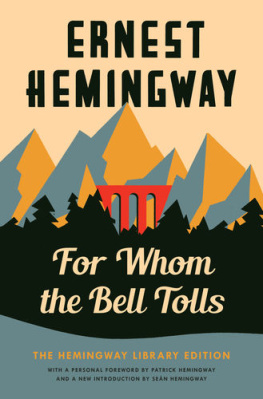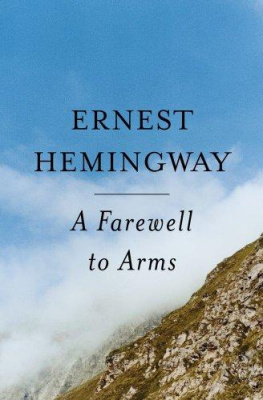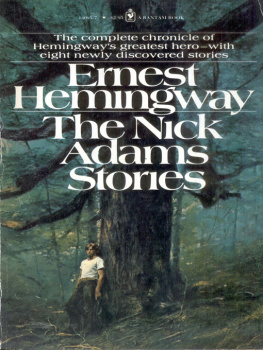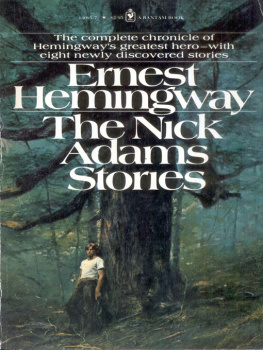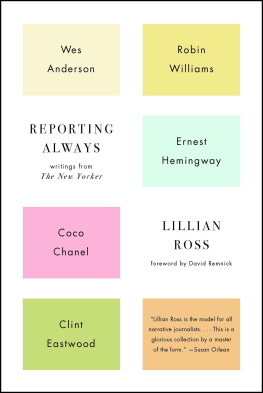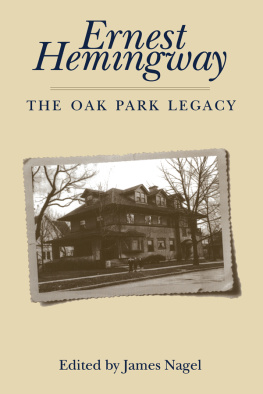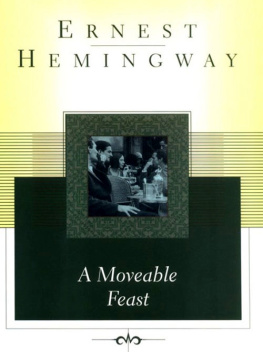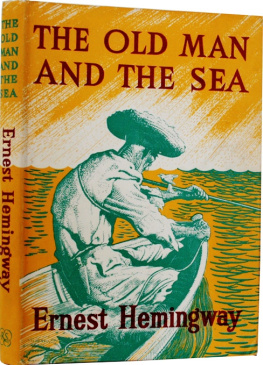Ernest Hemingway - A Moveable Feast
Here you can read online Ernest Hemingway - A Moveable Feast full text of the book (entire story) in english for free. Download pdf and epub, get meaning, cover and reviews about this ebook. genre: Art. Description of the work, (preface) as well as reviews are available. Best literature library LitArk.com created for fans of good reading and offers a wide selection of genres:
Romance novel
Science fiction
Adventure
Detective
Science
History
Home and family
Prose
Art
Politics
Computer
Non-fiction
Religion
Business
Children
Humor
Choose a favorite category and find really read worthwhile books. Enjoy immersion in the world of imagination, feel the emotions of the characters or learn something new for yourself, make an fascinating discovery.

- Book:A Moveable Feast
- Author:
- Genre:
- Rating:4 / 5
- Favourites:Add to favourites
- Your mark:
- 80
- 1
- 2
- 3
- 4
- 5
A Moveable Feast: summary, description and annotation
We offer to read an annotation, description, summary or preface (depends on what the author of the book "A Moveable Feast" wrote himself). If you haven't found the necessary information about the book — write in the comments, we will try to find it.
A Moveable Feast — read online for free the complete book (whole text) full work
Below is the text of the book, divided by pages. System saving the place of the last page read, allows you to conveniently read the book "A Moveable Feast" online for free, without having to search again every time where you left off. Put a bookmark, and you can go to the page where you finished reading at any time.
Font size:
Interval:
Bookmark:
A MOVEABLE FEAST
by Earnest Hemingway
A Triad Panther Book
Grandada Publishing
London Toronto Sydney New York
Published by Granada Publishing Limited in Panther Books 1977 Reprinted 1979
ISBN 0 586 04464 7
First published in Great Britain by
Jonathan Cape Ltd 1964
Copyright Ernest Hemingway Ltd 1964
eBook scanned & proofed by Binwiped 10-27-02 [v1.0]
Frontspiece :
Ernest Miller Hemingway was born in 1899. His father was a doctor and he was the second of six children. Their home was at Oak Park, a Chicago suburb.
In 1917 Hemingway joined the Kansas City Star as a cub reporter. The following year he volunteered to work as an ambulance driver on the Italian front where he was badly wounded but twice decorated for his services. He returned to America in 1919 and married in 1921. In 1922 he reported on the Greco-Turkish war then two years later resigned from journalism to devote himself to fiction. He settled in Paris where he renewed his earlier friendship with such fellow-American expatriates as Ezra Pound and Gertrude Stein. Their encouragement and criticism were to play a valuable part in the formation of his style.
Hemingway's first two published works were Three Stories and Ten Poems and In Our Time but it was the satirical novel, The Torrents of Spring, which established his name more widely. His international reputation was firmly secured by his next three books:
Fiesta, Men Without Women and A Farewell to Arms.
He was passionately involved with bullfighting, big-game hunting and deep-sea fishing, and his writing reflected this. He visited Spain during the Civil War and described his experiences in the bestseller, For Whom the Bell Tolls. His direct and deceptively simple style of writing spawned generations of imitators but no equals. Recognition of his position in contemporary literature came in 1954 when he was awarded the Nobel Prize, following the publication of The Old Man and the Sea. Ernest Hemingway died in 1961.
Also by Ernest Hemingway:
Novels
The Torrents of Spring
Fiesta
A Farewell to Arms
To Have and Have Not
For Whom the Bell Tolls
Across the River and Into the Trees
The Old Man and the Sea
Islands in the Stream
Stories
Men Without Women
Winner Take Nothing
The Snows of Kilimanjaro
General
Death in the Afternoon
Green Hills of Africa
Drama
The Fifth Column
Collected Work
The Essential Hemingway
The First Forty-Nine Stories
Contents
Preface
1 A Good Cafe on the Place St-Michel
2Miss Stein Instructs
3'Une Generation Perdue"
4Shakespeare and Company
5People of the Seine
6A False Spring
7The End of an Avocation
8Hunger Was Good Discipline
9Ford Madox Ford and the Devil's Disciple
10Birth of a New School
11With Pascin at the Dome
12Ezra Pound and His Bel Esprit
13A Strange Enough Ending
14The Man Who Was Marked for Death
15Evan Shipman at the Lilas
16An Agent of Evil
17Scott Fitzgerald
18Hawks Do Not Share
19A Matter of Measurements
20There Is Never Any End to Paris
If you are lucky enough to have lived in Paris as a young man, then wherever you go for the rest of your life, it stays with you, for Paris is a moveable feast.
Ernest Hemingway to a friend, 1950
Ernest started writing this book in Cuba in the autumn of 1957, worked on it in Ketchum, Idaho, in the winter of 1958-9, took it with him to Spain when we went there in April, 1959, and brought it back with him to Cuba and then to Ketchum late that fall. He finished the book in the spring of 1960 in Cuba, after having put it aside to write another book, The Dangerous Summer, about the violent rivalry between Antonio Ordonez and Luis Miguel Dominguin in the bull rings of Spain in 195 9. He made some revisions of this book in the fall in 1960 in Ketchum. It concerns the years 1921 to 1926 in Paris.
M.H.
Preface
For reasons sufficient to the writer, many places, people, observations and impressions have been left out of this book. Some were secrets and some were known by everyone and everyone has written about them and will doubtless write more.
There is no mention of the Stade Anastasie where the boxers served as waiters at the tables set out under the trees and the ring was in the garden. Nor of training with Larry Gains, nor the great twenty-round fights at the Cirque d'Hiver. Nor of such good friends as Charlie Sweeny, Bill Bird and Mike Strater, nor of Andre Masson and Miro. There is no mention of our voyages to the Black Forest or of our one-day explorations of the forests that we loved around Paris. It would be fine if all these were in this book but we will have to do without them for now.
If the reader prefers, this book may be regarded as fiction. But there is always the chance that such a book of fiction may throw some light on what has been written as fact.
ernest hemingway
San Francisco de Paula, Cuba 1960
1 A Good Caf on the Place St-Michel
Then there was the bad weather. It would come in one day when the fall was over. We would have to shut the windows in the night against the rain and the cold wind would strip the leaves from the trees in the Place Contrescarpe. The leaves lay sodden in the rain and the wind drove the rain against the big green autobus at the terminal and the Cafe des Amateurs was crowded and the windows misted over from the heat and the smoke inside. It was a sad, evilly run cafe where the drunkards of the quarter crowded together and I kept away from it because of the smell of dirty bodies and the sour smell of drunkenness. The men and women who frequented the Amateurs stayed drunk all of the time, or all of the time they could afford it, mostly on wine which they bought by the half-litre or litre. Many strangely named aperitifs were advertised, but few people could afford them except as a foundation to build their wine drunks on. The women drunkards were called poivrottes, which meant female rummies.
The Cafe des Amateurs was the cesspool of the rue Mouffetard, that wonderful narrow crowded market street which led into the Place Contrescarpe. The squat toilets of the old apartment houses, one by the side of the stairs on each floor with the two cleated cement shoe-shaped elevations on each side of the aperture so a locataire would not slip, emptied into cesspools which were emptied by pumping into horse-drawn tank wagons at night. In the summer time, with all windows open, we would hear the pumping and the odour was very strong. The tank wagons were painted brown and saffron colour and in the moonlight when they worked the rue Cardinal Lemoine their wheeled, horse-drawn cylinders looked like Braque paintings. No one emptied the Cafe des Amateurs though, and its yellowed poster stating the terms and penalties of the law against public drunkenness was as flyblown and disregarded as its clients were constant and ill-smelling.
All of the sadness of the city came suddenly with the first cold rains of winter, and there were no more tops to the high white houses as you walked but only the wet blackness of the street and the closed doors of the small shops, the herb sellers, the stationery and the newspaper shops, the midwife - second class - and the hotel where Verlaine had died, where I had a room on the top floor where I worked.
It was either six or eight flights up to the top floor and it was very cold and I knew how much it would cost for a bundle of small twigs, three wire-wrapped packets of short, half-pencil length pieces of split pine to catch fire from the twigs, and then the bundle of half-dried lengths of hard wood that I must buy to make a fire that would warm the room. So I went to the far side of the street to look up at the roof in the rain and see if any chimneys were going, and how the smoke blew. There was no smoke and I thought about how the chimney would be cold and might not draw and of the room possibly filling with smoke, and the fuel wasted, and the money gone with it, and I walked on in the rain. I walked down past the Lycee Henri Quatre and the ancient church of St-Etienne-du-Mont and the windswept Place du Pantheon and cut in for shelter to the right and finally came out on the lee side of the Boulevard St-Michel and worked on down it past the Cluny and the Boulevard St-Germain until I came to a good cafe that I knew on the Place St-Michel.
Font size:
Interval:
Bookmark:
Similar books «A Moveable Feast»
Look at similar books to A Moveable Feast. We have selected literature similar in name and meaning in the hope of providing readers with more options to find new, interesting, not yet read works.
Discussion, reviews of the book A Moveable Feast and just readers' own opinions. Leave your comments, write what you think about the work, its meaning or the main characters. Specify what exactly you liked and what you didn't like, and why you think so.

